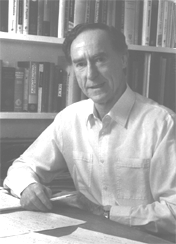George Batchelor facts for kids
Quick facts for kids
George Keith Batchelor
|
|
|---|---|

George Keith Batchelor
|
|
| Born | 8 March 1920 Melbourne, Australia
|
| Died | 30 March 2000 (aged 80) Cambridge, England
|
| Nationality | Australian |
| Alma mater | University of Melbourne |
| Known for | Batchelor vortex Prandtl–Batchelor theorem Batchelor–Chandrasekhar equation Batchelor scale |
| Awards | Adams Prize (1950) Royal Medal (1988) Timoshenko Medal (1988) |
| Scientific career | |
| Fields | Applied mathematics Fluid dynamics |
| Institutions | University of Cambridge |
| Doctoral advisor | Geoffrey Ingram Taylor |
| Doctoral students | Philip Saffman Keith Moffatt Adrian Gill |
George Keith Batchelor (8 March 1920 – 30 March 2000) was a very important Australian scientist. He was an applied mathematician and a fluid dynamicist. This means he used math to solve real-world problems, especially those involving how liquids and gases move.
He spent many years as a professor at the University of Cambridge in England. He also started a major department there, called the Department of Applied Mathematics and Theoretical Physics (DAMTP). In 1956, he created a famous science magazine called the Journal of Fluid Mechanics. He was its editor for about 40 years! Before Cambridge, he studied at Melbourne High School and the University of Melbourne in Australia.
Contents
Understanding Fluid Dynamics
George Batchelor worked with another famous scientist, Sir Geoffrey Taylor. They studied turbulent flow. Imagine water rushing in a river or smoke swirling from a chimney. That's turbulent flow. It's very complex to understand.
Why Physical Understanding Matters
Batchelor believed that to truly understand math problems, especially in fluid dynamics, you needed to understand the real-world physics behind them. He also thought it was important to do experiments to test ideas. This way, the math would match what actually happens.
His Classic Book
In 1967, he wrote a book called An Introduction to Fluid Dynamics. It's still considered one of the best books on the subject. What made it special was how it explained how real liquids, which are a bit sticky or "viscous," behave. Most books at the time didn't focus on this as much.
Batchelor's Legacy and Awards
George Batchelor was recognized for his amazing work. He was elected a special member of the American Academy of Arts and Sciences in 1959.
The Batchelor Prize
There is even a special award named after him, called the Batchelor Prize. This prize is given out every four years to a scientist who has made big contributions to fluid mechanics. It's a way to remember his important work and inspire new scientists.

